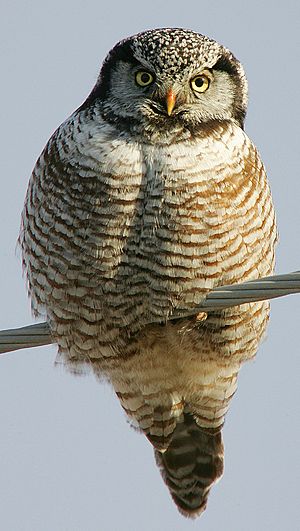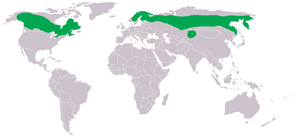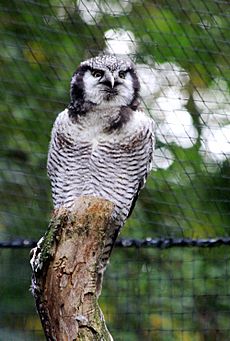Northern hawk-owl facts for kids
The northern hawk-owl (Surnia ulula) is a medium-sized true owl that lives in northern parts of the world. Unlike most owls, it is active during the day, not at night. It usually stays in its home area and does not migrate. Sometimes, though, many hawk-owls might fly further south than usual.
The name Surnia was made up by André Marie Constant Duméril, who first described this type of owl. The word ulula comes from Latin and means "screech owl."
Quick facts for kids Northern Hawk-Owl |
|
|---|---|
 |
|
| Conservation status | |
| Scientific classification | |
| Kingdom: | |
| Phylum: | |
| Class: | |
| Order: | |
| Family: | |
| Genus: |
Surnia
Duméril, 1805
|
| Species: |
S. ulula
|
| Binomial name | |
| Surnia ulula (Linnaeus, 1758)
|
|
 |
|
Contents
About the Northern Hawk-Owl
Male northern hawk-owls are usually about 36–42.5 cm (14.2–16.7 in) long. They weigh around 300 g (11 oz). Females are a bit bigger, measuring 37.2–44.7 cm (14.6–17.6 in) and weighing about 340 g (12 oz).
Both males and females have wingspans of about 45 cm (18 in). Their feathers are dark brown with off-white spots on their back. The back of their neck has a black V-shape.
The owl's belly is white or off-white, with brown stripes on its chest and stomach. It also has a long tail with brown bands. The northern hawk-owl has a smoky white face with a black edge, a flat head, yellow eyes, and a yellow curved beak.
Many people say the northern hawk-owl looks and acts like a hawk.
Amazing Senses for Hunting
Northern hawk-owls are special because they hunt during the day. Most owls hunt at night. To be good daytime hunters, they have amazing senses, especially their eyes and ears.
Sharp Eyesight
The northern hawk-owl has excellent eyesight. This is very important for hunting when it's light outside. Here's what makes their eyes so special:
- Their eyes are very big compared to their head. Big eyes help them see better, even when the light is not super bright.
- Like other owls, their eyes face forward. This gives them "binocular vision." It means they use both eyes at the same time. This helps them judge distances very well, which is key for catching fast prey!
- They can see very clearly, even from far away. This helps them spot small animals like mice from high up in a tree.
- Unlike humans, owls cannot move their eyes in their sockets. So, to look in different directions, they must turn their whole head.
- Northern hawk-owls can turn their heads up to 270 degrees. That's almost all the way around! They have special bones in their necks. These allow them to turn their heads without hurting themselves. They have more neck bones (14 compared to our 7) and special blood vessels. These keep blood flowing to their brain even when they turn their heads far.
Incredible Hearing
Northern hawk-owls also have amazing hearing. This helps them find prey even when they cannot see it. Here's what makes their ears so special:
- Their ear openings are not in the same place on each side of their head. One ear is usually higher than the other. This helps them figure out exactly where a sound is coming from.
- They have special feathers around their face. These feathers form a "facial disc." This disc helps collect and direct sounds towards their ears, like a satellite dish.
- Northern hawk-owls can even hear prey moving under the snow! They can hear the tiny sounds of a vole digging tunnels. Then they can dive down to catch it.
Owl Calls and Sounds
Northern hawk-owls make different sounds for different reasons. Males and females use various calls in different situations.
- When a male wants to attract a mate, he usually makes a rolled whistle sound like ulululululululul. He might also make a sound similar to tu-wita-wit, tiwita-tu-wita, wita when sitting at a possible nest spot.
- The female's call is usually not as steady and sounds more sharp.
When there is danger, the northern hawk-owl makes a sound like rike, rike, rike, rike. If an intruder comes too close to the nest, it lets out a high-pitched scream followed by a yip. To warn its young about danger, the hawk-owl will make a noise similar to ki ki kikikikiki. These calls can last from 15 seconds to 2 minutes.
Where Northern Hawk-Owls Live
There are three types of northern hawk-owls found across the northern parts of the world.
- The North American type lives from eastern Alaska across Canada to Newfoundland. In some places, it goes south into the northern United States.
- The other two types live in Eurasia. S. u. tianschanica breeds in central Asia, reaching Xinjiang in China.
- S. u. ulula lives across Eurasia, reaching Siberia in the east.
Northern Hawk-Owl Homes
Northern hawk-owls are found in different numbers across the boreal forest. They mostly live in open coniferous forests. These are forests with trees like pine and spruce. They also live in coniferous forests mixed with deciduous trees like larch, birch, poplar, and willow.
You can find them in swampy areas, clearings, swamp valleys, meadows, or places where fires have recently burned. They usually stay away from very thick spruce-fir forests. In winter, they tend to live in the same types of places as they do in summer.
Life Cycle and Reproduction
The northern hawk-owl usually starts its mating season in early March. After the male and female find each other, they build a nest and the female starts laying eggs. On average, a northern hawk-owl will lay 3 to 11 eggs in one group.
Nest sites are often the tops of hollow stumps of old, dead spruce trees. The female northern hawk-owl usually sits on the eggs to keep them warm. Meanwhile, the male hunts for food.
Once the chicks hatch, their roles change. About two weeks after the chicks are born, the female starts leaving the nest for long periods, sometimes 5 hours or more. This is probably when she hunts. The male, however, will guard the nest very carefully until the chicks leave.
If predators, like other raptors, fly nearby, the male will sometimes chase them away from the nest. When the young owls are big enough to need less looking after, they leave the nest. This usually happens after about 21 days, sometimes as early as mid-June. After this, the female provides most of the care. The male stays close and still feeds his young sometimes.
Northern hawk-owls have also been known to build nests on cliffs. They are not very afraid of humans. They will attack if you get too close to their young.
What Northern Hawk-Owls Eat
The northern hawk-owl eats many different animals. These can range from small rodents to larger mammals, and various birds. This is a common diet for many owls that live in boreal forests.
In Eurasia, northern hawk-owls mostly eat voles from the Microtus family. Baby hares are also an important part of their diet. Other important prey for the northern hawk-owl include the red squirrel. Red squirrels can make up as much as 20% of the hawk-owl’s food.
They also eat mice, rats, voles, lemmings, short-tail weasels, partridge, spruce grouse, doves, pileated woodpeckers, sparrows, jays, robins, starlings, buntings, grackles, and finches. In winter, their hunting changes. In summer, they mainly eat mammals. But in winter, a larger part of their food comes from ground-dwelling birds, like the ptarmigan and the grouse.
The northern hawk-owl hunts during the day, but it has been seen hunting at different times. It does not seem to have a favorite time to hunt.
Northern Hawk-Owls in Falconry
In Ontario, Canada, the northern hawk-owl is considered a falconry bird. People with the right license can use it to hunt small animals.
Images for kids
See also
 In Spanish: Cárabo gavilán para niños
In Spanish: Cárabo gavilán para niños




